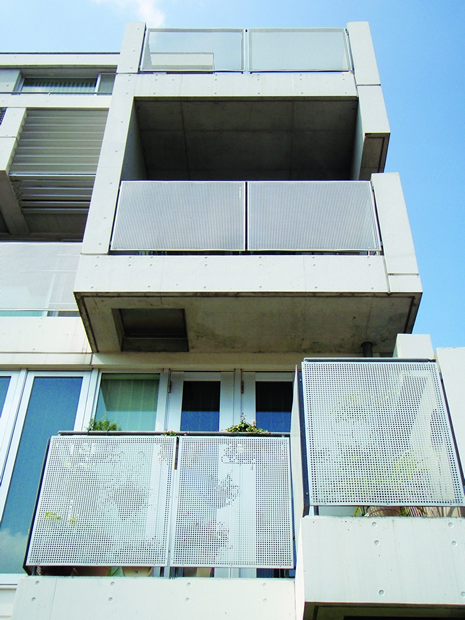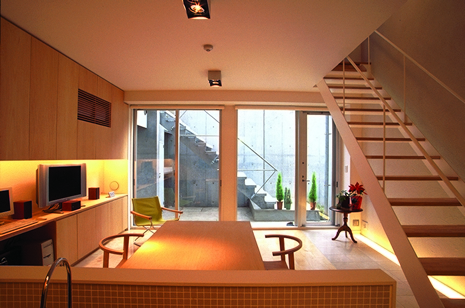Description
This project description is an excerpt from the longer article “Infill and Puntal Interventions”. For a comparative analysis and further data on this and all other categories including accompanying graphs, please see the article “A Turning Point”.
Another collective housing sharing similar unit variation and individuation is the Umegaoka Cooperative Housing ROXI completed earlier in 2003 by Satoshi Sasaki from SGM Architect & Associates.
1
“Umegaoka Cooperative House ROXI: SGM Architect & Associates, Tarao Hiiro Architects, Takehiko Higa Architect & Associates, Atelier-YY,” Japan Architect 56 (Winter 2005): 88–89.
Commissioned by a cooperative with households of differing needs, the architects set about customizing each housing unit within a formally cohesive whole. Located along a main road, the white, reinforced-concrete project crowned with a galvanized steel roof rises up four storeys above grade, setting itself apart from its neighboring residences. Spanning a site area of 417 square meters or the equivalent of nearly four single-family detached units length-wise, the northern façade is relatively closed and sombre, interspersed with several small steel-framed windows and a 1.5-storey screen of steel bars defining part of the G- and K-Units. In contrast, the southern façade is much more playful, with its mosaic-like façade of full-length windows of various shapes and sizes and unadorned white concrete expressing the highly-specialized living conditions and the unit variation within. In fact, seen from afar, the southern façade looks like a section cut through the building, although once further up close, the three-dimensional forms of the projecting balconies and roof terraces reinforce the sculptural effect of this concrete structure with a total built area of 910 square meters. Inside, the project houses a collection of flats, maisonettes, and lofts, with a total of 11 unique units: Units A, D, H, and J were designed by Naoko Tarao from Tarao Hiiro Architects; Units B, E, F, and I were designed by Higa Takehiko from Takehiko Higa Architects & Associates; while Units C, G, and K were designed by Yamamoto Yūsuke from Atelier-YY. Of the four units done by Naoko Tarao, the maisonette in Unit A was for a couple in their forties and can be accessed directly from the main road on the first level as well as from a stairway leading down to the basement terrace court.
2
Tarao Hiiro Architects, “Umegaoka Cooperative House ROXI A-unit,” accessed November 17, 2013, http://www.taraohiiro.co.jp/umegaoka/A-unit/A-unit.html
Unit D was for a couple in their fifties who also had a dog. As the husband works as an illustrator and receives many guests in this live-work apartment, the maisonette is spatially divided into two distinct public and private realms. Unlike the minimalistic, white walls and wooden flooring of Unit A, the interior of Unit D reflects the personalities of its inhabitants with its bright, colorful washes, and playful curved surfaces and slanted lines. In addition, each room is endowed with its own character with unique wall colors and finishing.
3
Tarao Hiiro Architects, “Umegaoka Cooperative House ROXI D-unit,” accessed November 17, 2013, http://www.taraohiiro.co.jp/umegaoka/D-unit/D-unit.html
Unit H located right above Unit D was for a couple in their thirties who desired a small home office environment. Within the apartment, all the service and storage functions are arranged along the walls to create an open space in the center, with continuous lighting and ventilation provided by configuration as a double-height loft.
4
Tarao Hiiro Architects, “Umegaoka Cooperative House ROXI H-unit,” accessed November 17, 2013, http://www.taraohiiro.co.jp/umegaoka/H-unit/H-unit.html
The largest unit in the house, Unit J, was for a couple in their thirties with two young boys and designed with the children’s sightlines and movements in mind. More notably, the space under the roof was meant to be flexible, anticipating the future needs of the growing children.
5
Tarao Hiiro Architects, “Umegaoka Cooperative House ROXI J-unit,” accessed November 17, 2013, http://www.taraohiiro.co.jp/umegaoka/J-unit/J-unit.html
Footnotes
“Umegaoka Cooperative House ROXI: SGM Architect & Associates, Tarao Hiiro Architects, Takehiko Higa Architect & Associates, Atelier-YY,” Japan Architect 56 (Winter 2005): 88–89.
Tarao Hiiro Architects, “Umegaoka Cooperative House ROXI A-unit,” accessed November 17, 2013, http://www.taraohiiro.co.jp/umegaoka/A-unit/A-unit.html
Tarao Hiiro Architects, “Umegaoka Cooperative House ROXI D-unit,” accessed November 17, 2013, http://www.taraohiiro.co.jp/umegaoka/D-unit/D-unit.html
Tarao Hiiro Architects, “Umegaoka Cooperative House ROXI H-unit,” accessed November 17, 2013, http://www.taraohiiro.co.jp/umegaoka/H-unit/H-unit.html
Tarao Hiiro Architects, “Umegaoka Cooperative House ROXI J-unit,” accessed November 17, 2013, http://www.taraohiiro.co.jp/umegaoka/J-unit/J-unit.html
Drawings
Photos
 Exterior view
Exterior view
 Interior view of living space
Interior view of living space
Internal Links
Originally published in: Peter G. Rowe, Har Ye Kan, Urban Intensities: Contemporary Housing Types and Territories, Birkhäuser, 2014.